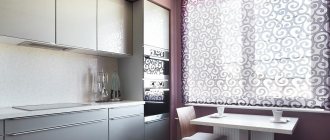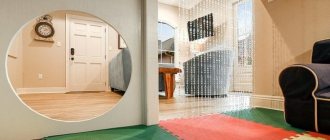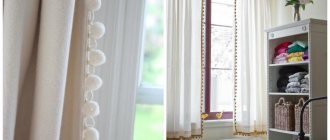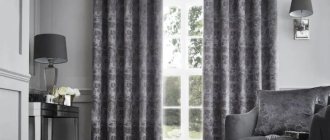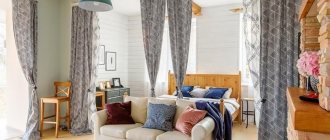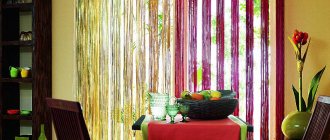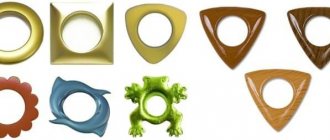Types of curtains for the living room
There are so many types and configurations of curtains that you can really get lost among them. The living room allows you to experiment with the most complex and original solutions that might be inappropriate in the kitchen or bedroom.
Classic curtains
Traditional curtains with curtains or tulle are in no hurry to lose ground. Especially in classic interiors. They can be decorated with tassels, clips, tiebacks, lambrequins, and create complex multi-level compositions.
Italian curtains
Italian curtains resemble classic ones, but with one significant difference: they do not slide apart along the eaves. You can open the window using side holders and grab bars. This is another traditional decorative solution for lush and rich styles.
Austrian curtains
Their lower part is gathered into beautiful decorative folds. Height and rise are adjustable using ties, loops and rings. These curtains are very elegant and decorative.
French curtains
Another decorative design reminiscent of its Austrian “colleagues”. The difference is that French curtains are gathered to the very top, along the entire length. They fall in graceful rounded waves and immediately give the room an atmosphere of solemnity.
English curtains
Another variation on the theme of curtains with tiebacks in height, but while Austrian and French curtains can have many such tiebacks, English curtains traditionally have two of them - with small indentations along the edges. In the best traditions of strict British classics.
Roman curtains
The age-old solution is now more relevant than ever: the best illustration of the cyclical nature of fashion. This is a dense canvas stretched over a rigid frame, which rolls out close to the window. It can be fixed at any height, completely opening or tightly closing the window.
Japanese curtains
Japanese curtains resemble a screen or those classic oriental sliding partitions. Lightweight vertical panels are stretched onto a frame that runs along the window.
Blackout
Blackout curtains completely block out sunlight, which is why they are most often used in bedrooms. But this option may also be appropriate in the living room. For example, if you often host movie nights in a makeshift home theater.
Priscilla curtains
In everyday life they are called crossed curtains. The two draperies are completely connected at the top edge, and the ends are pulled apart in different directions. The material is mostly translucent, because such curtains greatly darken the room. But they look soft and elegant.
Curtains-cafe
The café curtain frame is mounted in the middle of the window, not above it. They are rarely found in houses and apartments. But they create a comfortable and cozy effect of uniform diffused light in the room.
Types of materials and their key features
Wood – wood, first of all, has a great advantage in environmental friendliness. Also, wood and natural wood products always give a feeling of luxury. Pros: durability. Cons: heavy weight.
Plastic is a lightweight and economical material. Durability is affected not only by the quality of the material, but also by excess sunlight. Pros: savings. Cons: fragile.
Metal - forged metal really boasts all the criteria of luxury and durability, however, this design is not suitable for everyone. Fragile walls may simply not withstand the load over the years, and the fall of a metal curtain will not go unnoticed. Pros: luxury and durability. Cons: heavy weight.
Aluminum – great for using lightweight curtains, tulles and drapes. Pros: average strength, cost-effectiveness. Cons: Doesn't support a lot of weight.
Methods for attaching curtains
With roller blinds everything is clear: the design is worked out in advance. You just need to secure it above the window. But classic curtains can be attached in different ways. Fortunately, the living room allows this too!
Ties
The canvas is attached to the cornice using laces, ribbons or braid. This option is not suitable for very heavy fabrics, because the knots will constantly unravel. But elegant bows will only emphasize the elegance of an airy curtain or tulle with an openwork floral pattern.
Loops
Ready-made decorative loops immediately run along the top of the curtain, which are put on the cornice. They differ from ties in that they do not need to be tied by hand. The loops can be solid or with fasteners in the form of buttons, buttons, or Velcro. The quantity is calculated taking into account the width and weight of the canvas.
Backstage
The cornice is inserted into an improvised fabric tunnel, similar to the hood tightening principle. Due to the absence of hard fasteners, such curtains are the quietest, but they are difficult to remove for washing and drape beautifully.
Braid
Decorative braid is sewn on top of the curtain, which creates small and frequent uniform folds. This texture cannot be replicated using other fasteners. Keep in mind that the piece of fabric for the braid should be one and a half to two times wider than the window opening.
Eyelets
Eyelets are special rings inserted into holes along the top of the curtain. They can be made of plastic or metal. If you make them to match the fabric, the eyelets are almost invisible when installed. And their main advantage is textured and uniform folds even on heavy curtains.
Rings and clamps
Curtain rings are one of the most common solutions in Europe and America. They differ from eyelets in that they are attached to the top edge of the fabric, rather than being “built into” it. Therefore, it is easier to remove such curtains from the cornice.
Living room interior design: features and ideas (70 photos)
How to fix the cornice and attach curtains
First of all, in any installation, follow the rule “measure twice, cut once.” This golden rule will help you estimate and mark the position of the future curtain so that it is as comfortable to use as possible, and also complements the decor smoothly and reliably.
All markings are made using a level, since not only the appearance, but also the uniformity of the load depends on this. The approximate markings are made standard at a distance from the window sill (5 cm), and thanks to the wide range and types of fastenings, ring clips, eyelets or hooks can be used.
It all depends on the type of installation and the load that will be placed on the mount.
Curtains are a great way to decorate any type of room. It is as diverse as possible and allows the designer’s imagination to swing in any direction, be it classic or new modern.
The main thing is to always be guided by the practicality of use and do not forget that only high-quality materials can serve you for a long time and bring maximum comfort to your home.
Curtains for zoning the living room
Curtains and textile partitions are one of the classic ways of zoning space in the living room. Despite its simplicity, this solution has a number of advantages.
- Low cost. Even luxurious, expensive curtains are cheaper than complex stationary structures made of wood or glass;
— Easy to install. Hanging a curtain is much easier than installing a plasterboard partition. Anyone can do this easily;
- Mobility. If necessary, the curtains can be removed without leaving a trace. Of course, folding screens can also be removed, but even when folded they take up space, unlike a piece of fabric;
- Variety. Curtains can be easily changed according to the situation and mood. Updating textiles is the easiest way to refresh any interior;
- Easy to care for. It is enough to wash the curtains in the machine and hang them back.
But there are also disadvantages. Firstly, you will have to think about how to integrate the cornice into the ceiling structure. Secondly, textiles in the interior always require careful care, because even the most modern fabrics gradually absorb odors and dust.
Using curtains you can separate a soft corner, a work area, or an additional sleeping area. They will fit perfectly into combined studios for a symbolic separation of the kitchen, dining area, and living room itself.
Design options for non-standard windows
The main advantage of atypical openings is individuality and uniqueness. Properly selected curtains will help highlight the features of their architecture.
Bay window frame
A bay window is a composition consisting of several windows that protrude outside the room. The unity of the design must not be violated, so a pair of curtains located on both sides is usually used. For the correct placement of accents, the bay window is designed in the form of a theater curtain.
Curtains for roof windows
Sliding models that will be fixed from below are suitable, since the window is located at an angle. A good solution would be curtains with grommets, but an additional rod for the lower part is mounted. Installing Roman blinds allows you to adjust the lowering and raising of the model to the required level.
Arched window decor
Arched windows once adorned old medieval castles and became a symbol of greatness and nobility. But today you can build the same openings in your home. The curtains are located below the curve so that all the beauty of the structure remains visible. The curtains are secured with rivets at the bottom.
Curtains for French windows
The ideal solution is an interior with a window without curtains, as seen in the photo. Suitable for apartments located on high floors where neighbors will not be able to see inside. As a result, the room will become more spacious and bright.
Unique French windows without curtains in the interior
On the lower floors and in private houses, the windows are decorated with stained glass or stickers. If you still need curtains, then select products from lightweight fabrics that do not block the flow of sunlight.
Selecting curtains in accordance with the purpose and design of the room will be the most correct decision. It is important to pay attention to color, material, and decorative elements. Only in this case the window opening will become a real decoration of the whole house.
Curtains in different interior styles
A variety of shapes, fabrics and colors makes it easy to choose curtains for the living room to suit any interior. Both luxurious baroque and technological futurism will not be left without beautiful and functional curtains.
Country romance
Country, Provence, chalet, shabby chic, boho and their variations are cozy and warm village houses. Choose natural fabrics, pastel shades, floral patterns, small and elegant decor. Flounces, openwork inserts, braid, and tiebacks look good.
Pay attention to all the curtains falling in waves: Austrian, French and even more austere English. For a rough living room interior, linen curtains are good. Even burlap can be used to good effect in country music.
Palace luxury
Lush Baroque, Rococo, Empire, palace classics - all this requires scope and monumentality. Choose expensive luxurious fabrics, because even capricious velvet will be appropriate here. Create complex multi-level compositions.
Use abundant gold and silver decor, heavy lambrequins, voluminous tassels, and tiebacks. Change organza tulle to natural silk with embroidery. And for the most luxurious classic interiors, curtains are sewn by hand.
Pragmatic minimalism
Stylish technological minimalism, ultra-modern high-tech and eclectic contemporary still do not refuse curtains in the living room. The shape and materials are not so important here, but feel free to experiment with textures and colors.
Combine different fabrics and create bright accents from curtains. The right choice of textiles is the best alternative to excessive decor that does not fit into the concept of minimalism. Even the most laconic living room will become creative and individual.
Cozy eco-trends
In recent years, eco-trends and the maximum rejection of artificial materials have remained in fashion. This is reflected in different directions: from the popular Scandinavian style to the decorative Mediterranean style. In addition to natural fabrics, use the same natural shades: beige, brown, sand, green, blue. Instead of abstract geometry, there are sophisticated plant motifs. Such curtains are good with loops and ties.
Artistic industrialization
Even a rough and pragmatic industrial loft still uses textiles. And especially its softer and more neutral “descendants”, such as grunge in the interior.
Pay attention to the long thick bright curtains that cover the entire wall from ceiling to floor. Extend a long cornice and leave a small niche in the corner, and then, if desired, the windows can be fully opened and the curtains hidden. Or use roll structures. Roman curtains of their coarse fabrics in discreet terracotta, graphite, concrete shades will fit into the loft like family.
Curtains for the kitchen (65 photos): types, beautiful ideas
Roman models
They are in high demand among consumers because they are an alternative to both blinds and classic curtains. Products are made from dense materials, which are assembled into neat folds using a lifting mechanism. Roman blinds are universal, often installed in kitchens and minimalist modern interiors.
Roman curtains are successfully combined in color with sofa cushions and decor, creating a single ensemble
Combining curtains to decorate windows in the living room
Creamy white curtains in the bedroom
Curtains for the bedroom in a classic style
Curtains for a small living room
Voluminous, expressive curtains and multi-level compositions are unlikely to suit a small living room. When saving space comes to the fore, choose curtains that fit as closely as possible to the window.
A good and practical choice is Roman blinds. They are the most compact and functional, but at the same time many times more elegant than plastic blinds. Light French or Austrian curtains will fit into romantic interiors. But be sure to choose thin and airy fabrics.
The main rule for a small living room is the simpler the better. Avoid massive designs and too dense and heavy fabrics. If you need complete protection from the sun, it is better to pay attention to blackout curtains than to massive velvet curtains.
Japanese curtains
They look laconic and elegant, convey a unique oriental flavor, therefore they are often installed in rooms with an ethnic style. The products are presented in smooth canvases that are mounted to a multi-layer cornice. Curtains are made from linen or cotton and are often decorated with traditional Japanese prints: cranes, hieroglyphs, cherry blossom branches. Ideal for decorating wide, large windows.
Multi-colored curtains with lambrequins in the bedroom
Window decoration with cream curtains with a lambrequin in the kitchen
Window decoration in the nursery
Curtains for the living room - photo
Can’t finally decide on the choice of curtains for the living room and hall? Do not rush! We have prepared a large selection of photos for you. Perhaps this is where you will find your ideal option!
Curtains for the bedroom in a modern style (70 photos)
Design recommendations
Today, the emphasis is not only on fashionable fabric and spectacular tailoring, but also the aesthetics of attaching the curtain composition is important. Modern methods of fastening have replaced the obsolete “crocodiles” and rings.
Masters of curtain sewing use hidden ceiling cornices or open methods of decorating curtains. These are eyelets, wide loops with buttons and Velcro, as well as curtain tape.
The stylish design of a window opening largely depends on the quality of the fabric. Natural fibers are valued for their environmental friendliness, but synthetic materials are more practical. Kitchen curtains are made from crushed linen, translucent cambric and light voile.
For self-production, it is advisable to select curtain and curtain fabrics from mixed fibers in the middle price category.
Modern offers can be viewed in the catalogs and portfolios of curtain ateliers, which are readily shown to potential clients.
You will have to tinker with sewing a window composition with your own hands, but decorating windows with curtains will cost much less.
